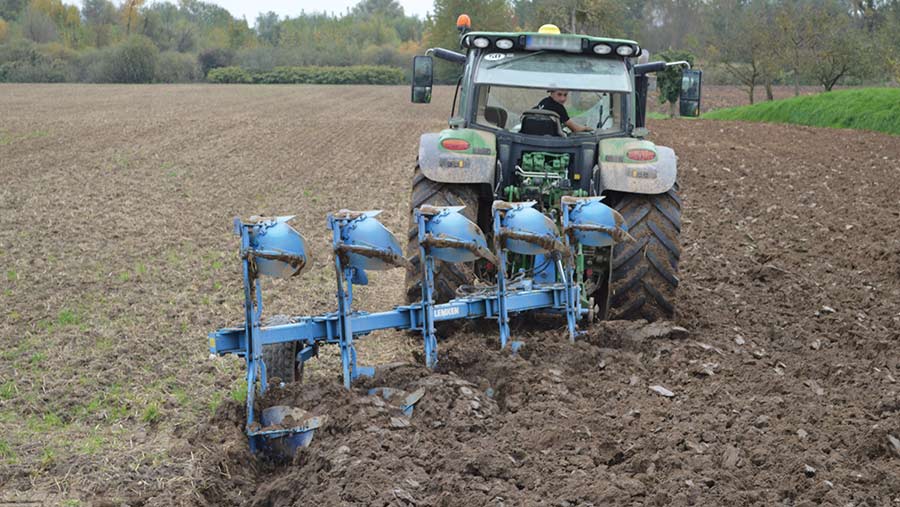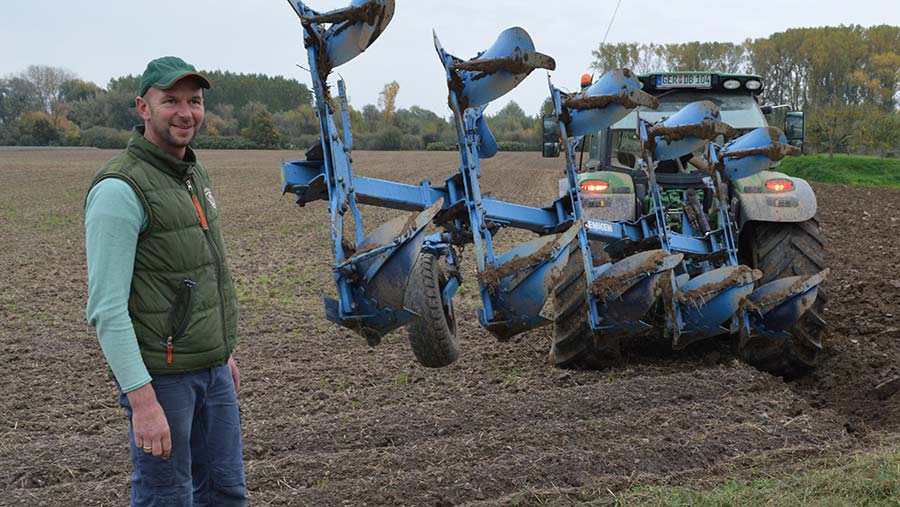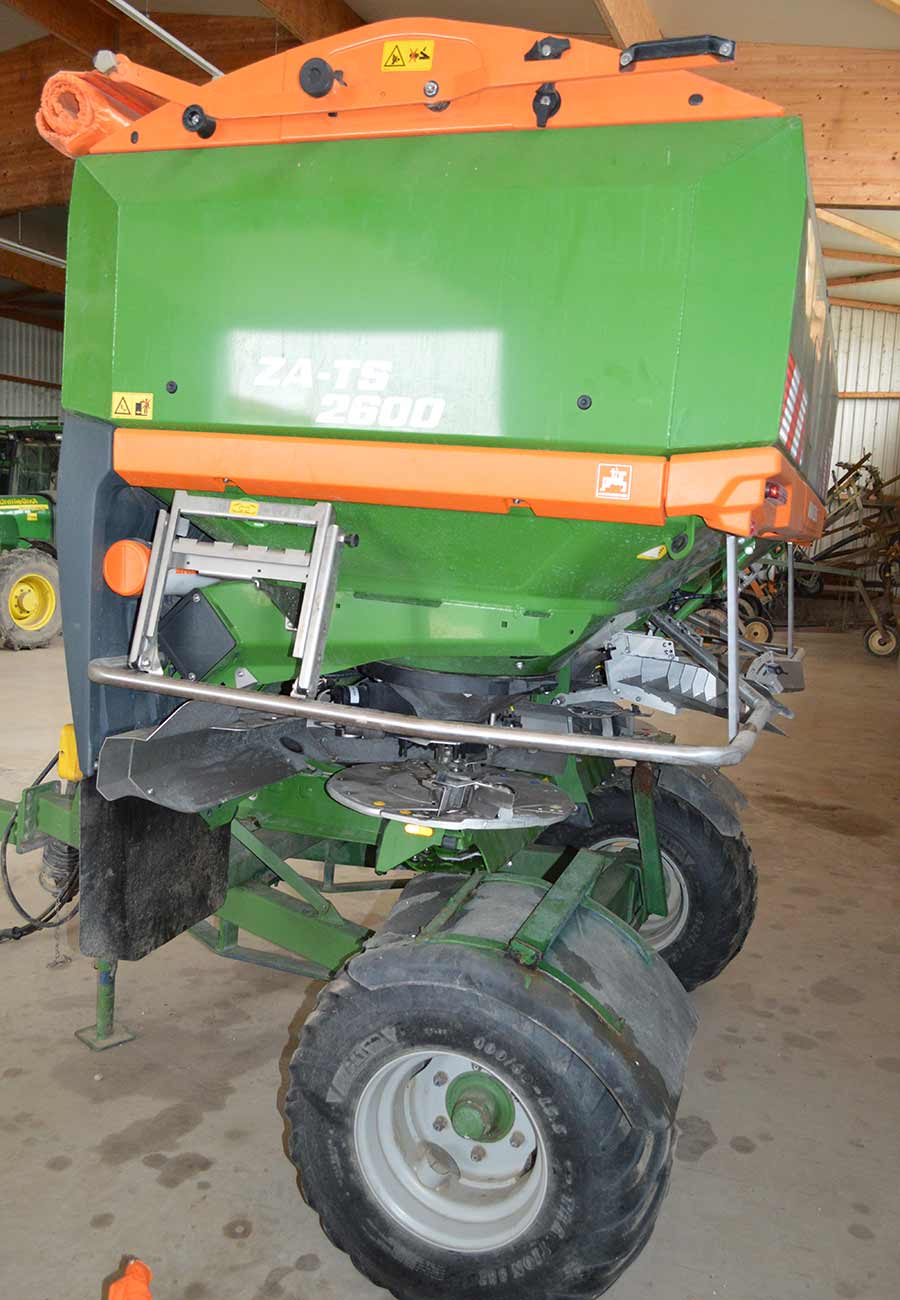Digital tools may bring an end to fungicide timings
 © MAG/David Jones
© MAG/David Jones Dominik Bellaire says traditional wheat fungicide spray timings will soon be a thing of the past as he switches to use a range of digital tools to pinpoint when exactly to treat his crops and also save money.
He believes industry-wide standards such as T1 and T2 spray timings will become obsolete as digital maps and weather forecasts tell him when and how much fungicide to spray to benefit his bottom line and the environment.
See also: Two new fungicides to fight septoria in wheat grower’s plans
Fungicide spray timings, including T0, T1, T2 and T3, are commonplace to protect particular leaves and also the ears of wheat crops from infection, but the digital world may push all that into history.
“T1,T2 and T3 spray timings – those are going to be gone. I want to spray only when I know the infection is coming,” Mr Bellaire tells Farmers Weekly on his mixed farm in the lower Rhine valley.

Dominik Bellaire © MAG/David Jones
Farm facts
Schmiedhof, Neupotz, Rhineland-Platinate, Germany
- Area 200ha
- Grows winter wheat, spring barley, rye, spelt, oilseed rape, sunflowers, maize, lucerne, carrots, tobacco and grazing land for the 60-strong milking herd
Spray timings
These spray timings were developed to give growers the best time to treat crops, with T0 sprays applied in early spring designed to protect leaf four, T1s set to protect leaf three and give some protection to the soon-to-emerge leaf two, T2s to protect leaf one or the flag leaf, and T3s to protect the ear from late diseases.
Now Mr Bellaire’s digital tools are telling him when to spray – even if it is in the middle of the night – and only use the minimal amount of crop protection products to protect his profits and help biodiversity.
“Compared with the standard amounts, I am saving money by using the right timings and the right amounts of fungicides,” he says. Average yields of winter wheat on his farm are about 8t/ha.
Mr Bellaire has been employing a widely used farm management software package, Myfarm24, for a number of years.
The software digitally maps out his 200ha farm at Schmiedhof, near Neupotz, some 60 miles south of Frankfurt and just north of Karlsruhe.
With this system he can load his sprayer tractor terminal from his smartphone, which tells his sprayer to shut off individual nozzles when approaching a field margin or around a stream or ditch, and also avoid skylark nests.
Variety of crops
The farm grows a wide variety of crops such as winter wheat, spring barley, maize, sunflowers, lucerne, carrots, tobacco, rye, oilseed rape and spelt, as well as grassland for a 60-strong dairy cow herd to graze.
This range of crops, as well as the farm being split between heavy land near the Rhine and light land away from the river, make the digital mapping very important.
The next step was to add software to give him recommendations of whether to spray based on a number of factors such as weather – including wind, rain and humidity – and disease pressure.
For the past three years he has worked with the Xarvio digital system, developed by agrochemical giant BASF, which gives recommendations for actions to take using a wide range of products, and not just those from BASF.
For the 40ha of milling winter wheat Mr Bellaire grows, 48 hours of leaf wetness on his wheat plants will give him an alert that the wet weather conditions have been met to encourage septoria infection.
Disease signals
This signals to him that the disease could appear in his crop within 10-16 days.
Within the Xarvio data will be the variety he is growing and its drilling date, as well as a host of weather data reinforced by a weather station on his farm.
He can use from one up to four fungicide sprays for his winter wheat throughout the season, depending on weather and disease pressure.
His first spray on his winter wheat for septoria tends to be at the end of April or early May, or around the T1 timing, but his digital guide helps make the key timing decisions.
In dry springs, he can skip an early T0, like some growers in the UK, and spray only when there is a real disease threat.
He trusts the digital decisions made by the system and is quite prepared to spray even when he can not see disease – such as septoria – in his crops when the system warns him that disease is bubbling up under the leaf surface.
He is aware of the need for transparency, as he farms on the edge of a village and customers come to the farm to buy his milk, so he is keen to encourage other farmers to follow this approach.
“If the window to spray is in the night and we need to go, then we need to be able to explain why we are spraying then,” he says.
Fertiliser spreading
By using satellite images of crop biomass, the digital tool can also be used to apply just the right amount of fertiliser.
This is especially important as 40ha of the farm is in a “red” area, where nitrogen fertiliser is restricted due to the risk of it leaching into groundwater.
In these red areas, nitrogen is restricted to 20% less than 170kg/ha allowed under current German rules, so applying the fertiliser in the most efficient way is key to meeting these restrictions and still producing good-quality milling wheat.

© MAG/David Jones
In the same way, satellite-produced maps are drawn up to allow the most efficient use of seed at drilling to give low numbers in poor areas of a field and higher seed number in more fertile areas.
In a country that is losing the equivalent of 80 football fields of arable land every day to alternate uses such as housing, industry and roads, the most efficient use of inputs becomes vital while mitigating the effect of arable cropping on the environment and biodiversity.
Saving the skylark
Dominik Bellaire is part of a pilot project to protect skylarks, whose population is considered to be a key indicator of biodiversity.
He and other participating growers in the area are creating so-called “lark windows” – open areas in wheat crops to allow birds to nest and take off and land.
The wheat is used by regional baker Gortz to produce “Lark’s bread” at a small price premium to benefit the farmers and a local flour mill.
Mr Bellaire believes biodiversity should concern everyone, and he is interested to see if consumers will be prepared to pay a little bit more for the “Lark’s bread”.

